TOYOTA YARIS HYBRID 2014 Owners Manual
Manufacturer: TOYOTA, Model Year: 2014, Model line: YARIS HYBRID, Model: TOYOTA YARIS HYBRID 2014Pages: 464, PDF Size: 23.4 MB
Page 361 of 464
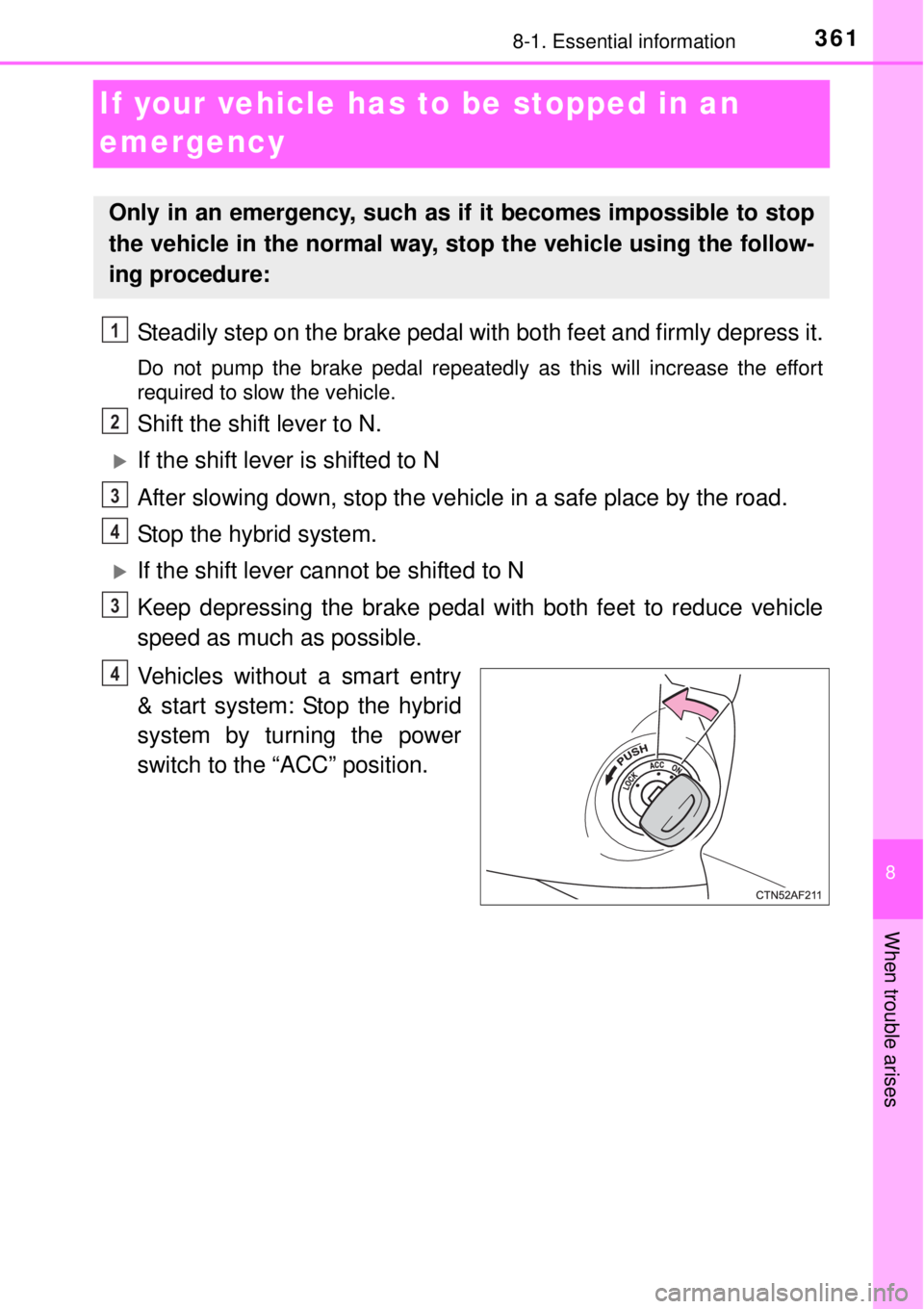
3618-1. Essential information
8
When trouble arises
If your vehicle has to be stopped in an
emergency
Steadily step on the brake pedal with both feet and firmly depress it.
Do not pump the brake pedal repeatedly as this will increase the effort
required to slow the vehicle.
Shift the shift lever to N.
If the shift lever is shifted to N
After slowing down, stop the vehicle in a safe place by the road.
Stop the hybrid system.
If the shift lever cannot be shifted to N
Keep depressing the brake pedal with both feet to reduce vehicle
speed as much as possible.
Vehicles without a smart entry
& start system: Stop the hybrid
system by turning the power
switch to the “ACC” position.
Only in an emergency, such as if it becomes impossible to stop
the vehicle in the normal way, stop the vehicle using the follow-
ing procedure:
1
2
3
4
3
4
Page 362 of 464
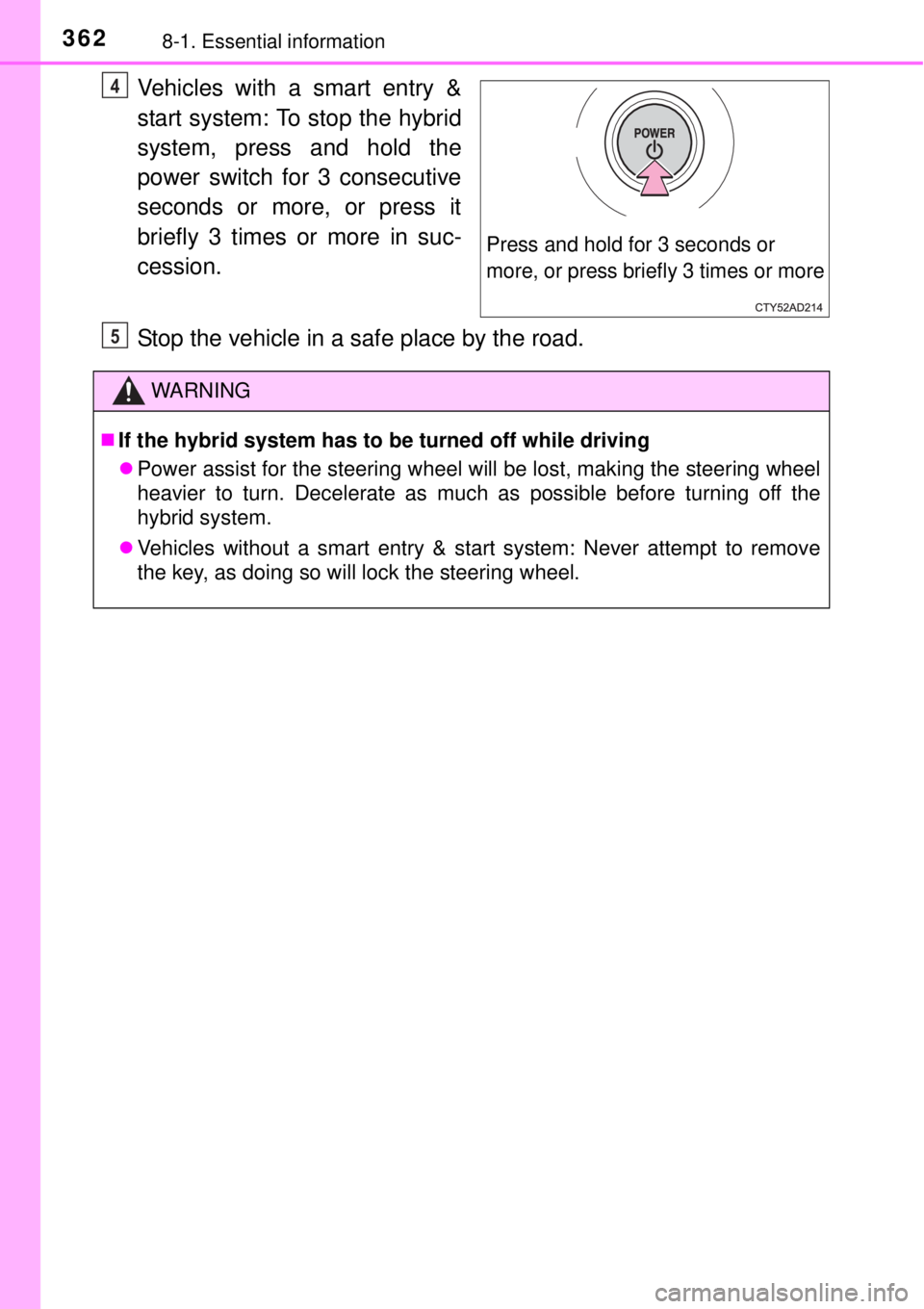
3628-1. Essential information
Vehicles with a smart entry &
start system: To stop the hybrid
system, press and hold the
power switch for 3 consecutive
seconds or more, or press it
briefly 3 times or more in suc-
cession.
Stop the vehicle in a safe place by the road.
Press and hold for 3 seconds or
more, or press briefly 3 times or more
4
WARNING
If the hybrid system has to be turned off while driving
Power assist for the steering wheel will be lost, making the steering wheel
heavier to turn. Decelerate as much as possible before turning off the
hybrid system.
Vehicles without a smart entry & start system: Never attempt to remove
the key, as doing so will lock the steering wheel.
5
Page 363 of 464
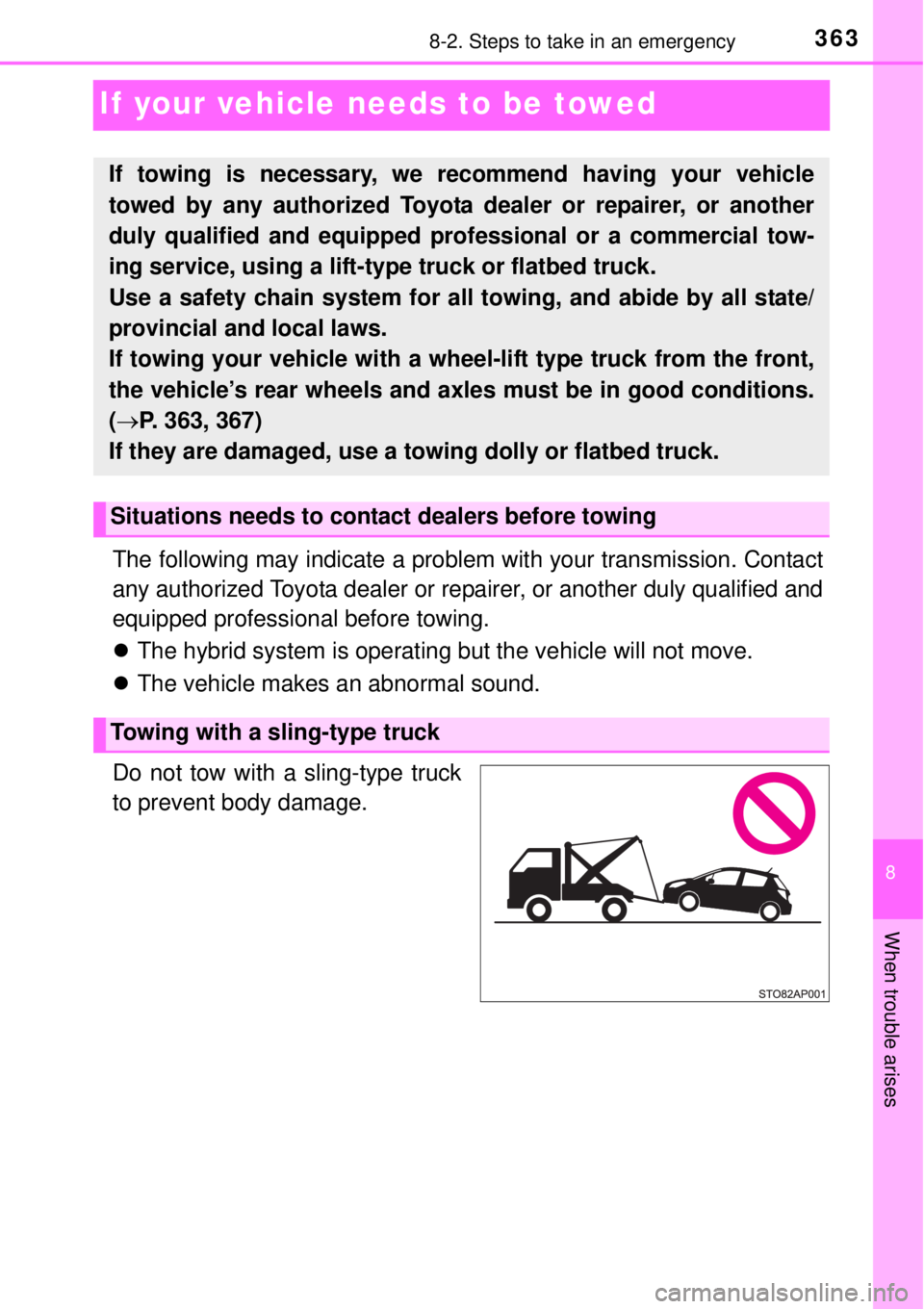
3638-2. Steps to take in an emergency
8
When trouble arises
If your vehicle needs to be towed
The following may indicate a problem with your transmission. Contact
any authorized Toyota dealer or repairer, or another duly qualified and
equipped professional before towing.
The hybrid system is operating but the vehicle will not move.
The vehicle makes an abnormal sound.
Do not tow with a sling-type truck
to prevent body damage.
If towing is necessary, we recommend having your vehicle
towed by any authorized Toyota dealer or repairer, or another
duly qualified and equipped professional or a commercial tow-
ing service, using a lift-type truck or flatbed truck.
Use a safety chain system for all towing, and abide by all state/
provincial and local laws.
If towing your vehicle with a wheel-lift type truck from the front,
the vehicle’s rear wheels and axles must be in good conditions.
(P. 363, 367)
If they are damaged, use a towing dolly or flatbed truck.
Situations needs to contact dealers before towing
Towing with a sling-type truck
Page 364 of 464
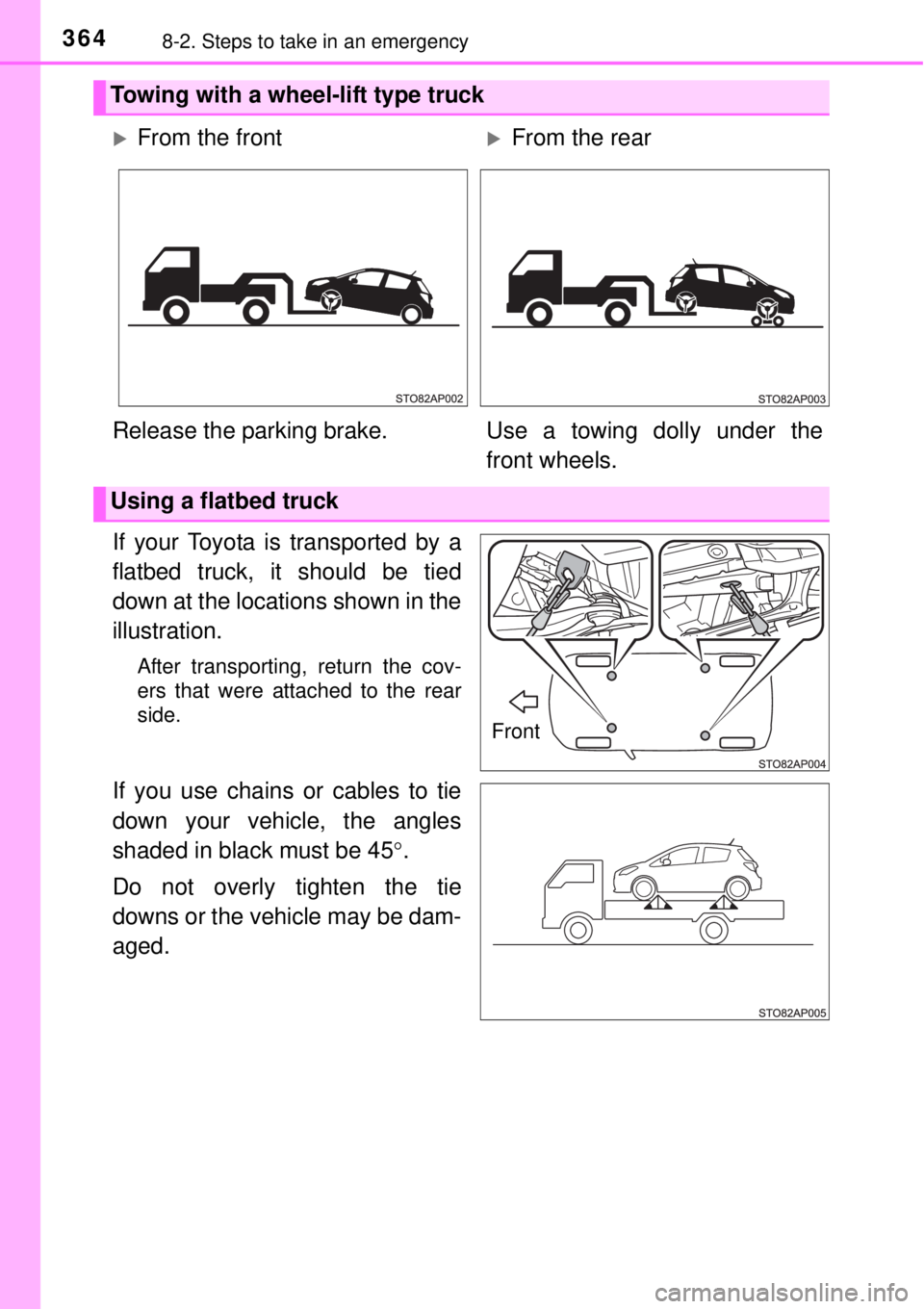
3648-2. Steps to take in an emergency
If your Toyota is transported by a
flatbed truck, it should be tied
down at the locations shown in the
illustration.
After transporting, return the cov-
ers that were attached to the rear
side.
If you use chains or cables to tie
down your vehicle, the angles
shaded in black must be 45.
Do not overly tighten the tie
downs or the vehicle may be dam-
aged.
Towing with a wheel-lift type truck
From the frontFrom the rear
Release the parking brake. Use a towing dolly under the
front wheels.
Using a flatbed truck
Front
Page 365 of 464
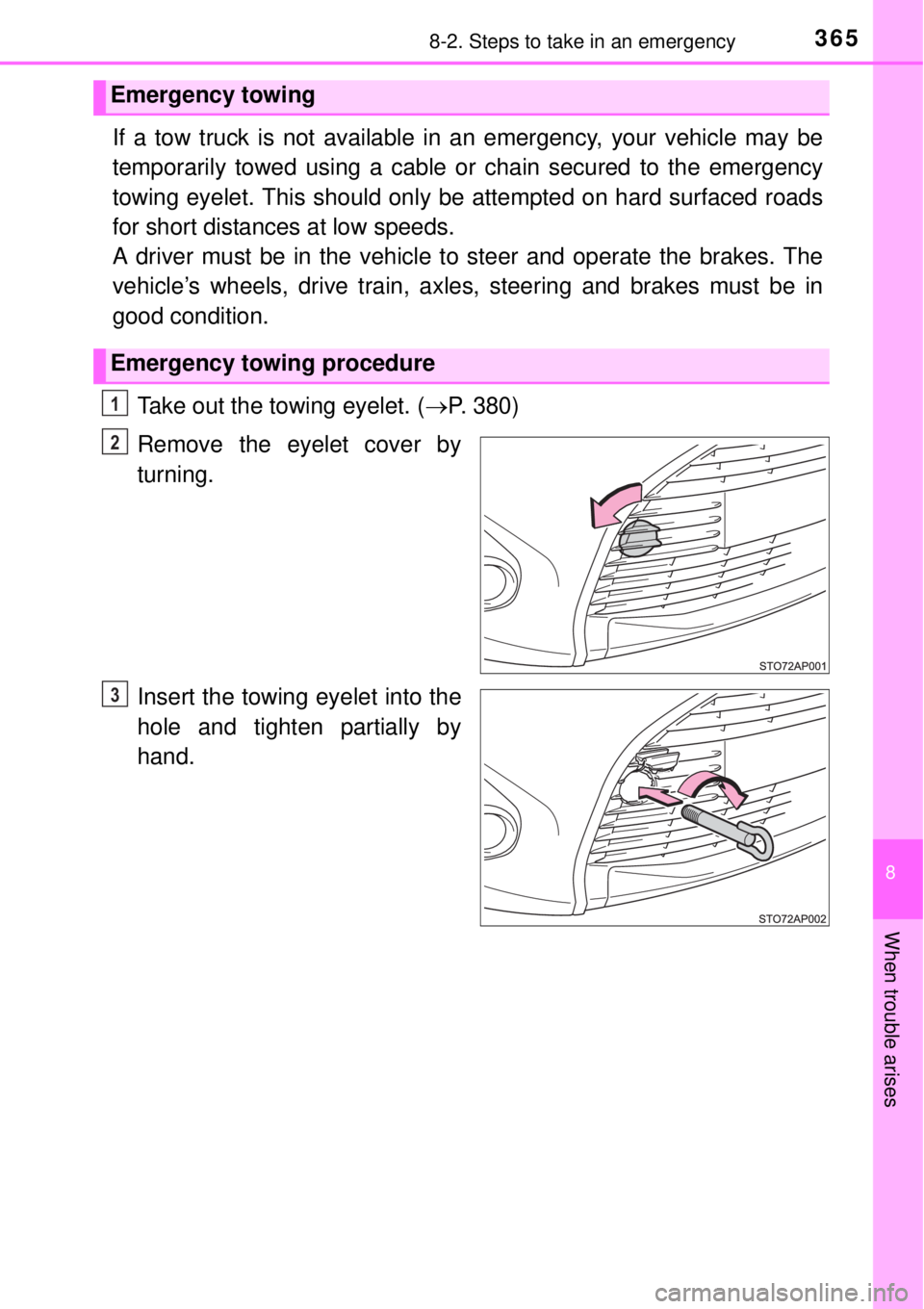
3658-2. Steps to take in an emergency
8
When trouble arises
If a tow truck is not available in an emergency, your vehicle may be
temporarily towed using a cable or chain secured to the emergency
towing eyelet. This should only be attempted on hard surfaced roads
for short distances at low speeds.
A driver must be in the vehicle to steer and operate the brakes. The
vehicle’s wheels, drive train, axles, steering and brakes must be in
good condition.
Take out the towing eyelet. (P. 380)
Remove the eyelet cover by
turning.
Insert the towing eyelet into the
hole and tighten partially by
hand.
Emergency towing
Emergency towing procedure
1
2
3
Page 366 of 464
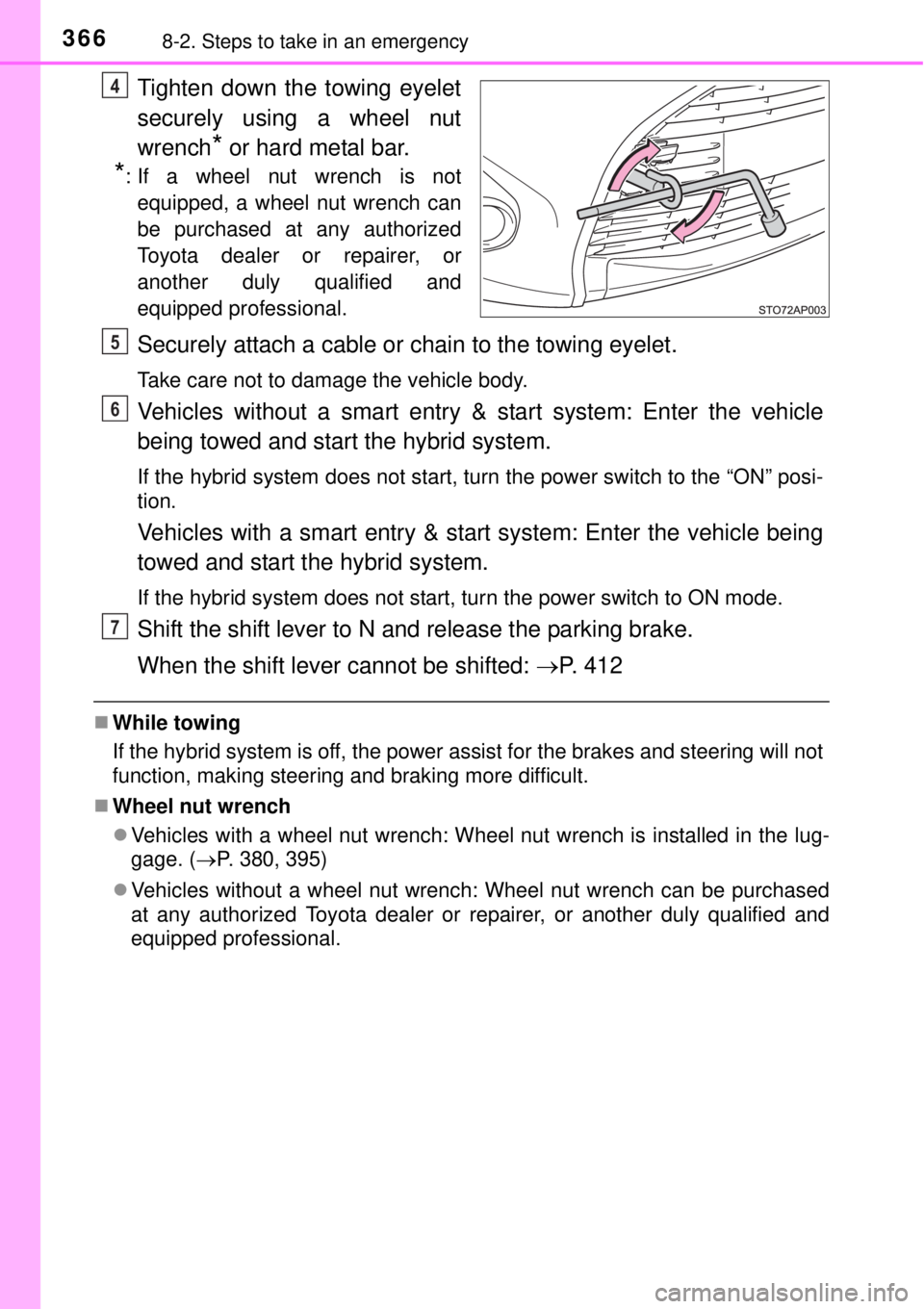
3668-2. Steps to take in an emergency
Tighten down the towing eyelet
securely using a wheel nut
wrench
* or hard metal bar.
*: If a wheel nut wrench is not
equipped, a wheel nut wrench can
be purchased at any authorized
Toyota dealer or repairer, or
another duly qualified and
equipped professional.
Securely attach a cable or chain to the towing eyelet.
Take care not to damage the vehicle body.
Vehicles without a smart entry & start system: Enter the vehicle
being towed and start the hybrid system.
If the hybrid system does not start, turn the power switch to the “ON” posi-
tion.
Vehicles with a smart entry & start system: Enter the vehicle being
towed and start the hybrid system.
If the hybrid system does not start, turn the power switch to ON mode.
Shift the shift lever to N and release the parking brake.
When the shift lever cannot be shifted: P. 4 1 2
While towing
If the hybrid system is off, the power assist for the brakes and steering will not
function, making steering and braking more difficult.
Wheel nut wrench
Vehicles with a wheel nut wrench: Wheel nut wrench is installed in the lug-
gage. (P. 380, 395)
Vehicles without a wheel nut wrench: Wheel nut wrench can be purchased
at any authorized Toyota dealer or repairer, or another duly qualified and
equipped professional.
4
5
6
7
Page 367 of 464
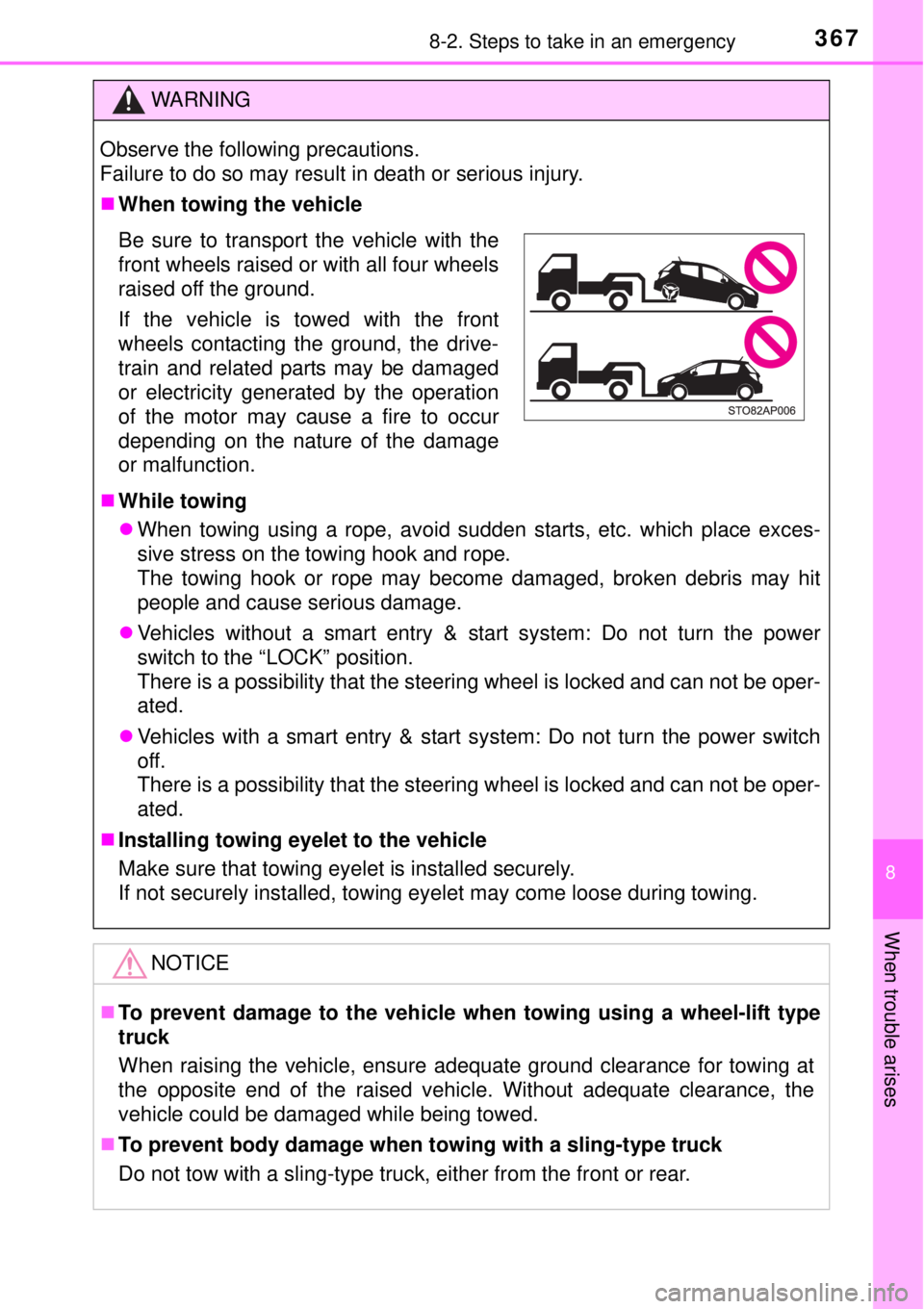
3678-2. Steps to take in an emergency
8
When trouble arises
WARNING
Observe the following precautions.
Failure to do so may result in death or serious injury.
When towing the vehicle
While towing
When towing using a rope, avoid sudden starts, etc. which place exces-
sive stress on the towing hook and rope.
The towing hook or rope may become damaged, broken debris may hit
people and cause serious damage.
Vehicles without a smart entry & start system: Do not turn the power
switch to the “LOCK” position.
There is a possibility that the steering wheel is locked and can not be oper-
ated.
Vehicles with a smart entry & start system: Do not turn the power switch
off.
There is a possibility that the steering wheel is locked and can not be oper-
ated.
Installing towing eyelet to the vehicle
Make sure that towing eyelet is installed securely.
If not securely installed, towing eyelet may come loose during towing.
NOTICE
To prevent damage to the vehicle when towing using a wheel-lift type
truck
When raising the vehicle, ensure adequate ground clearance for towing at
the opposite end of the raised vehicle. Without adequate clearance, the
vehicle could be damaged while being towed.
To prevent body damage when towing with a sling-type truck
Do not tow with a sling-type truck, either from the front or rear.
Be sure to transport the vehicle with the
front wheels raised or with all four wheels
raised off the ground.
If the vehicle is towed with the front
wheels contacting the ground, the drive-
train and related parts may be damaged
or electricity generated by the operation
of the motor may cause a fire to occur
depending on the nature of the damage
or malfunction.
Page 368 of 464
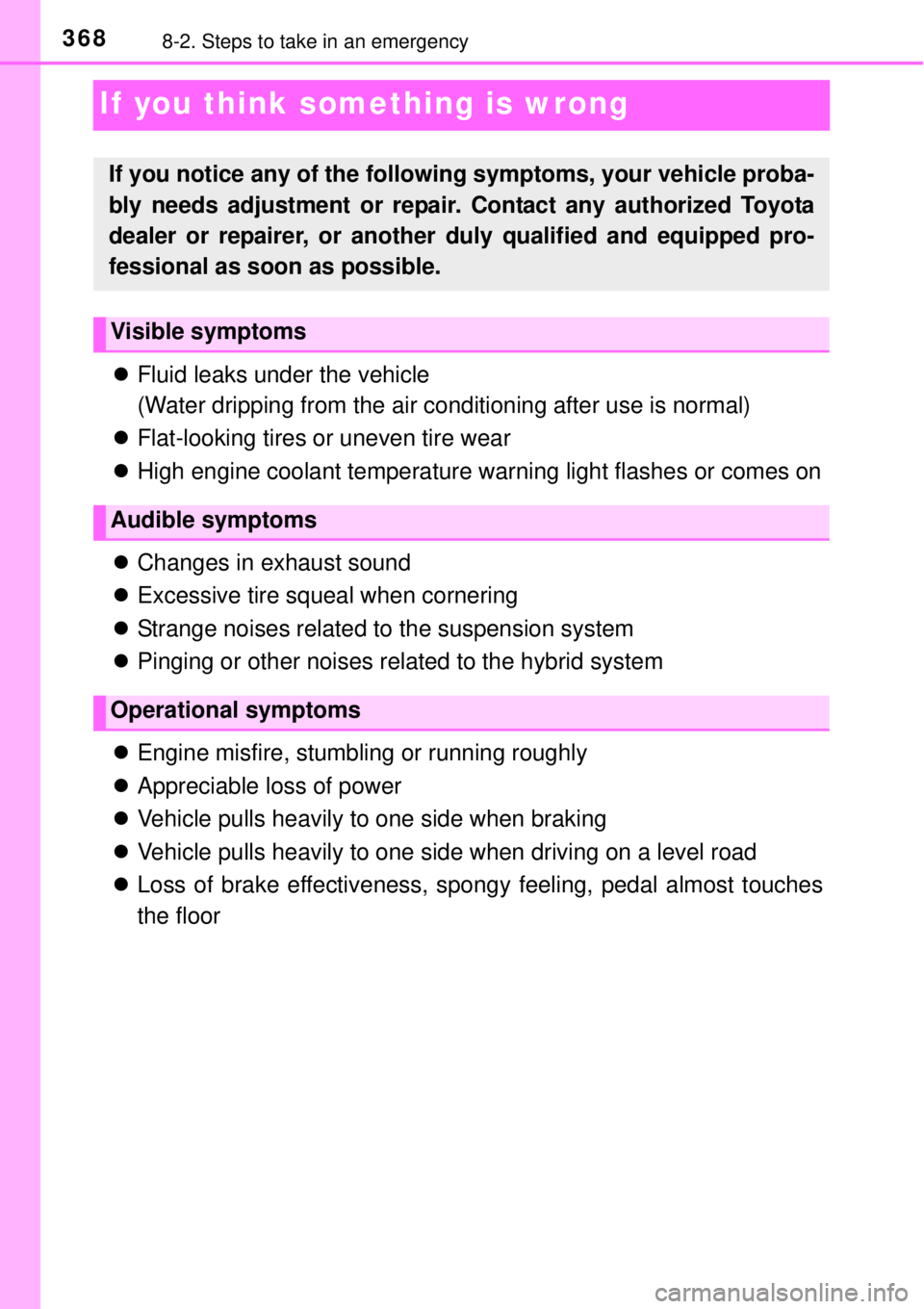
3688-2. Steps to take in an emergency
If you think something is wrong
Fluid leaks under the vehicle
(Water dripping from the air conditioning after use is normal)
Flat-looking tires or uneven tire wear
High engine coolant temperature warning light flashes or comes on
Changes in exhaust sound
Excessive tire squeal when cornering
Strange noises related to the suspension system
Pinging or other noises related to the hybrid system
Engine misfire, stumbling or running roughly
Appreciable loss of power
Vehicle pulls heavily to one side when braking
Vehicle pulls heavily to one side when driving on a level road
Loss of brake effectiveness, spongy feeling, pedal almost touches
the floor
If you notice any of the following symptoms, your vehicle proba-
bly needs adjustment or repair. Contact any authorized Toyota
dealer or repairer, or another duly qualified and equipped pro-
fessional as soon as possible.
Visible symptoms
Audible symptoms
Operational symptoms
Page 369 of 464
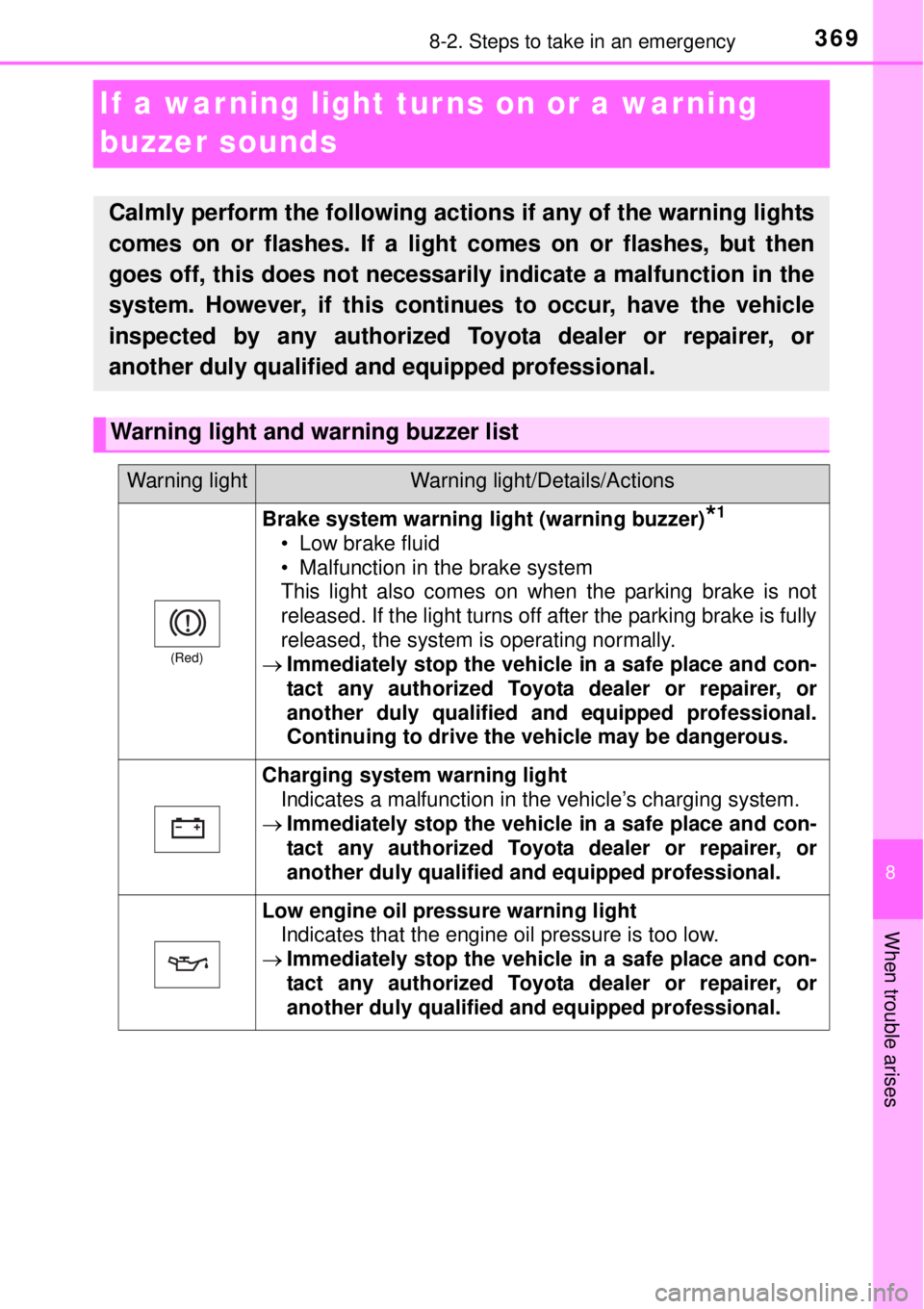
3698-2. Steps to take in an emergency
8
When trouble arises
If a warning light turns on or a warning
buzzer sounds
Calmly perform the following actions if any of the warning lights
comes on or flashes. If a light comes on or flashes, but then
goes off, this does not necessarily indicate a malfunction in the
system. However, if this continues to occur, have the vehicle
inspected by any authorized Toyota dealer or repairer, or
another duly qualified and equipped professional.
Warning light and warning buzzer list
Warning lightWarning light/Details/Actions
(Red)
Brake system warning light (warning buzzer)*1
• Low brake fluid
• Malfunction in the brake system
This light also comes on when the parking brake is not
released. If the light turns off after the parking brake is fully
released, the system is operating normally.
Immediately stop the vehicle in a safe place and con-
tact any authorized Toyota dealer or repairer, or
another duly qualified and equipped professional.
Continuing to drive the vehicle may be dangerous.
Charging system warning light
Indicates a malfunction in the vehicle’s charging system.
Immediately stop the vehicle in a safe place and con-
tact any authorized Toyota dealer or repairer, or
another duly qualified and equipped professional.
Low engine oil pressure warning light
Indicates that the engine oil pressure is too low.
Immediately stop the vehicle in a safe place and con-
tact any authorized Toyota dealer or repairer, or
another duly qualified and equipped professional.
Page 370 of 464
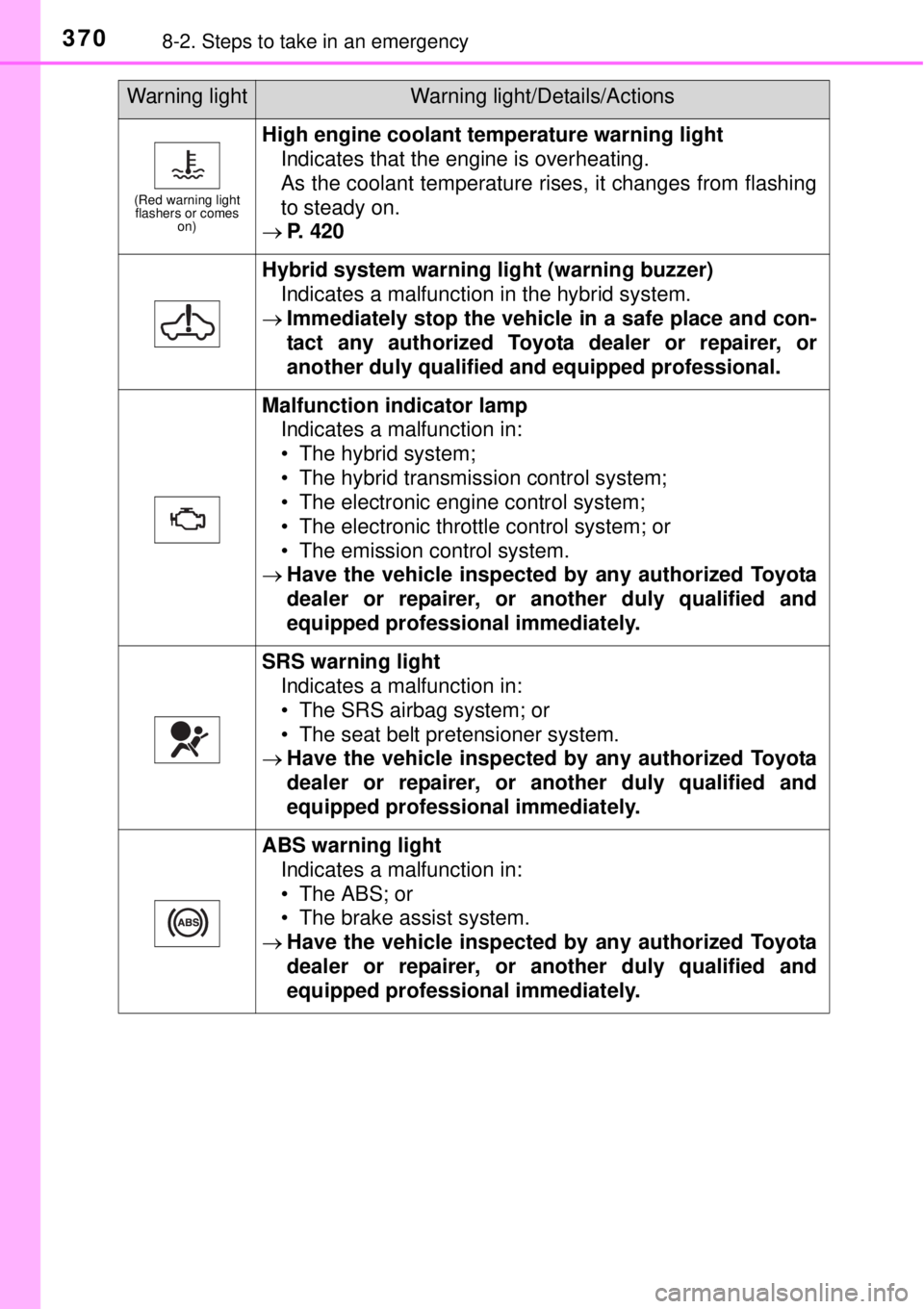
3708-2. Steps to take in an emergency
(Red warning light
flashers or comes
on)
High engine coolant temperature warning light
Indicates that the engine is overheating.
As the coolant temperature rises, it changes from flashing
to steady on.
P. 420
Hybrid system warning light (warning buzzer)
Indicates a malfunction in the hybrid system.
Immediately stop the vehicle in a safe place and con-
tact any authorized Toyota dealer or repairer, or
another duly qualified and equipped professional.
Malfunction indicator lamp
Indicates a malfunction in:
• The hybrid system;
• The hybrid transmission control system;
• The electronic engine control system;
• The electronic throttle control system; or
• The emission control system.
Have the vehicle inspected by any authorized Toyota
dealer or repairer, or another duly qualified and
equipped professional immediately.
SRS warning light
Indicates a malfunction in:
• The SRS airbag system; or
• The seat belt pretensioner system.
Have the vehicle inspected by any authorized Toyota
dealer or repairer, or another duly qualified and
equipped professional immediately.
ABS warning light
Indicates a malfunction in:
• The ABS; or
• The brake assist system.
Have the vehicle inspected by any authorized Toyota
dealer or repairer, or another duly qualified and
equipped professional immediately.
Warning lightWarning light/Details/Actions